A little over a month ago I found this juvenile Red-tailed Hawk just standing around on a gravel road in the Centennial Valley of Montana. It’s behavior seemed at least a little odd because I’d never seen this species act so nonchalant when perched so low for so long – especially on a road.
1/2500, f/11 (don’t ask me why…), ISO 500, 500 f/4, not baited, set up or called in
It didn’t even become nervous as I approached in my pickup. In fact it was more interested in this sauntering sparrow than it was in me and I don’t believe it was because it considered the sparrow to be potential prey.
1/3200, f/8, ISO 500, 500 f/4, not baited, set up or called in
As I slowly got closer it even squatted down on its haunches – a sure sign that it wasn’t nervous. This was the first time I’d seen this common posture in a red-tail while it was perched on the ground.
1/3200, f/7.1 ISO 500, 500 f/4, 1.4 tc, not baited, set up or called in
As I approached even more closely it did stand erect but then almost immediately tucked one foot up, which is another indicator of a lack of nervousness.
1/2500, f/8, ISO 500, 500 f/4, not baited, set up or called in
Even with me so close it was obviously scanning the roadside grass (lower right), probably for prey.
I can’t definitively explain this behavior but it’s my guess that it was a very young hawk (lack of fear) hunting grasshoppers along the road. The grasshoppers were incredibly thick and I observed and photographed several Prairie Falcons hunting and eating them (see link). Red-tailed Hawks eat vertebrates primarily, especially rodents, and you seldom see anything in their dietary statistics that includes any insects but I did see one reference (BNA) that said that the diet of red-tails in the Puerto Rican rain forest includes 13% arthropods (which includes insects).
So if this was a very young bird it would have been an inexperienced hunter and since there were so many grasshoppers available I suspect it decided to take advantage of the situation.
1/1600, f/6.3 ISO 500, 17-85 @ 78mm, not baited, set up or called in
This image should give you some perspective and show you how close I was to the hawk. I quickly grabbed one of my other cameras and took this shot at only 85mm. The blurred object at bottom is the “Noodle” I use on my window as a lens rest.
Anyway, nothing particularly momentous here but when you spend as much time watching raptors as I do these little quirks of behavior sort of stand out.
Ron


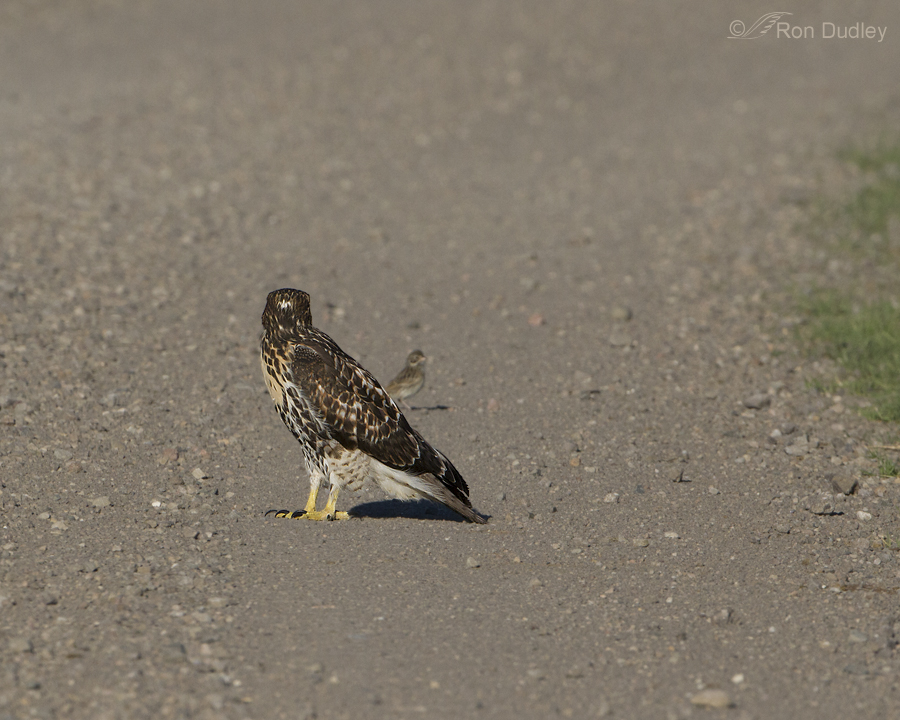
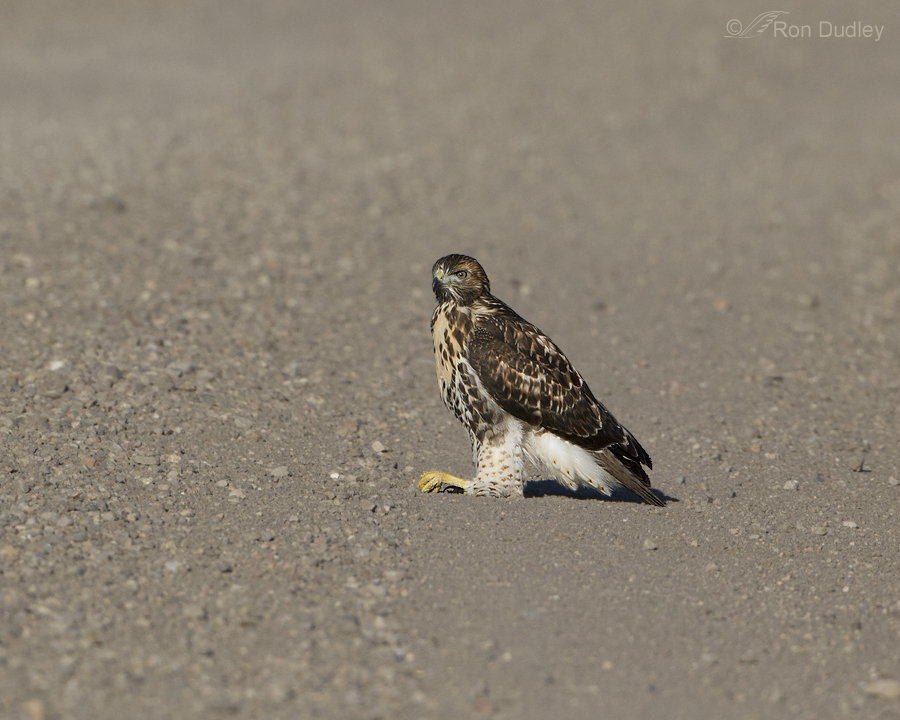
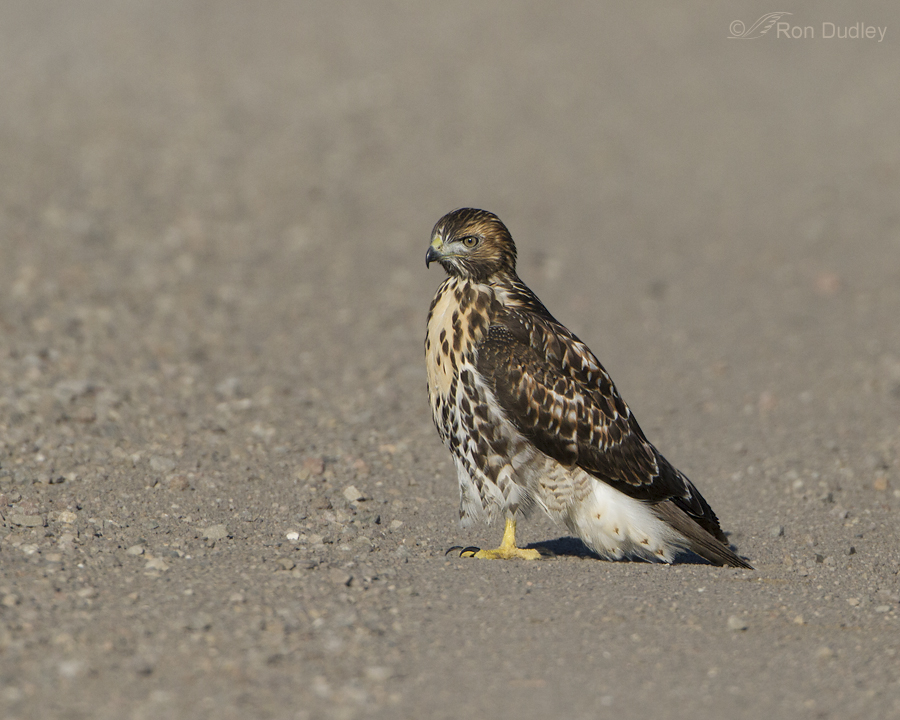
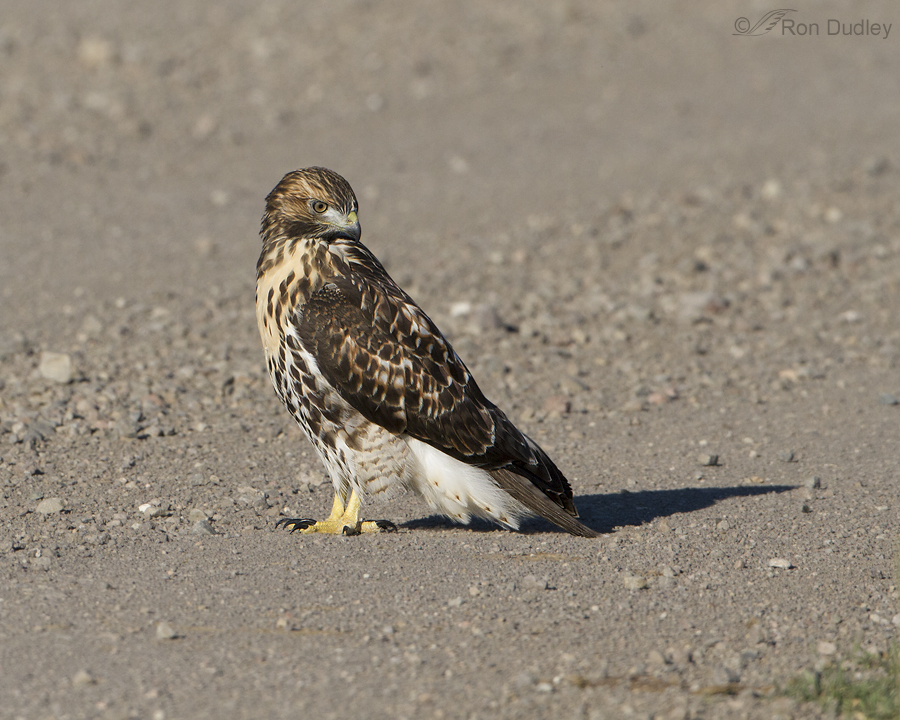
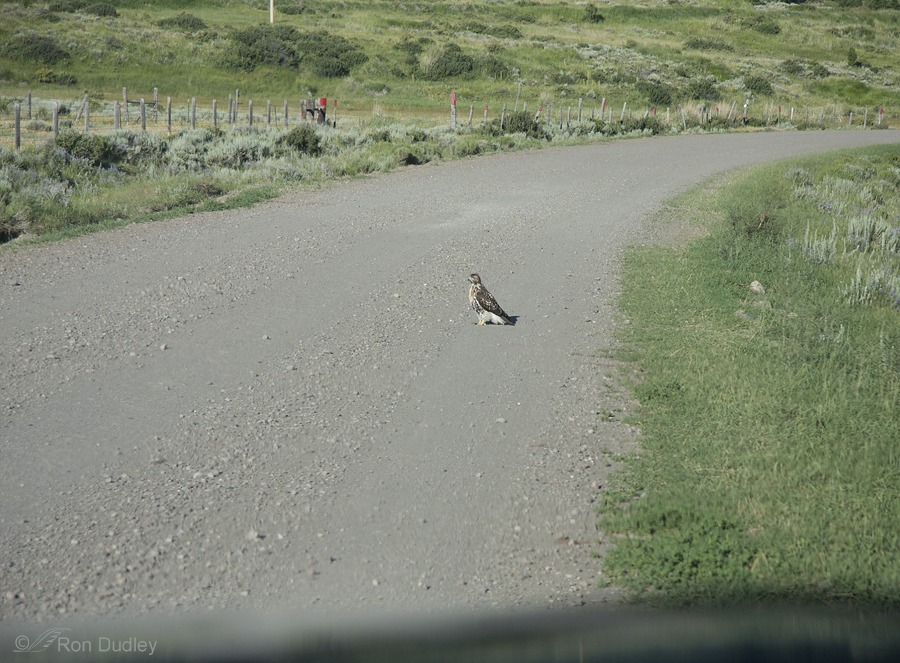
A very interesting post on young RT behavior, but also on depth of field as illustrated by the slice of in-focus gravel.
Red-tail hawks are my favorite raptors and I enjoy any and all info and pics about them. How wonderful that you got to be so close to it!
Loved the beautiful pictures. On the eaglecrest site the mother red tail hawk was seen feeding a young turkey vulture!
Thank you, Terri
That’s what I love about your blog, Ron — not just wonderful photography but thoughtful observations of behavior. We need to remember the root of our passion is bird *watching*.
Wonderful photos, what a gorgeous creature!!
Elephant’s child is a genius! Of course he was waiting for the chicken to cross the road….but the chicken was chicken! A word to the chicken: that ain’t no chicken hawk, honey…so don’t you worry your pretty little head. You go on and cross that there road whenever you feel like it!
Why did the Red-tailed Hawk stand in the road? It was waiting for the chicken. Which was late.
Frivolity aside, thank you. I loved this bird and, as I so often do, learned a lot from your post and from the wonderful comments. Thank you one and all.
I regret that I recommended this blog if others are going to use it to bash Cornell. Sadly, I will be removing the tweet leading people to this site.
I’m sorry you feel that way, Gretchen. But others have a right to their opinions (and I’m not in the habit of censoring comments) just as you have a right to tweet what you like.
But as I said below, I think BNA is a very valuable resource.
Wonderful pics and dialogue. The hawk is gorgeous. Gretchen got the word out and I owe her a big thank you. Gonna follow you now. 🙂
Thank you, Deborah.
These portraits are beautiful. Behavior very interesting, too. I love it that you could get so close to this bird.
Thanks, Susan. It was both fun and interesting to be that close.
Really neat Ron. It’s fun when they let you get such a close up view of their behaviors. I was just out this morning running my dogs & bird watching & sadly found a dead juvie burrowing owl that had recently been hit by a vehicle. It wasn’t in bad shape, so I picked it up for a friend who is an awesome bird taxidermist. He’s been doing some birds for a museum so he was thrilled when I called & offered it to him!
Thanks, Deb.
Incredibly awesome pics and commentary. Thanks to GP you will likely have many followers who love our feathered friends like me. 🙂
Thank you, Hawkmama. The more the merrier!
The BNA site is *so* extensive that you can read all day and not absorb it all. What an amazing resource!
I agree, Gretchen. It’s amazing what you can learn there. Even very “common” species often become fascinating based on some of the info available about them on BNA. I’ve heard some implied criticism of BNA in the past, especially as it relates to raptors, but for me it’s proven to be an extremely valuable resource.
Ron, if you look on the Cornell BNA site, Breeding, Fledgling section, it states, “Johnson (1986) reported that juveniles obtained food from migrant adults and other juveniles, as well as parents, between 4–6 wk after fledging.” This is the behavior William is referring to, I believe.
Found it, Gretchen. Thank you!
I’d like to think you’re right about why this young guy might be so unspooked, but can’t help wondering if he might be dazed because he might have been hit , or at least grazed, while hunting on the road. These youngsters have a lot to learn about vehicles, too. So often, it’s a juvenile you see dead on the road. It’s a sad fact their mortality rate is so high.
It’s possible, Patty but highly unlikely based on what I observed. This bird was very alert as it observed its environment, even though it was relaxed in my presence. And there’s very little traffic on this road – especially in the mornings. It’s not unusual for an hour to go by with no vehicles coming along.
Ron-the “alert to his environment” part is very reassuring.
Redtails in almost all their various ranges rely on insects as young juveniles to make the transition from natal nest to hunting far more mobile prey. Insects are normally available in large numbers to coincide with the fledge timing of many buteos not just Redtails. Their food web has evolved to provide “easy” hunting as they transition through the complexity of self hunting.
In regards to the individual seeming more “trusting” than others. Hawks have a variety of trust/tolerance levels between individuals but also within the individual. These levels can vary over a few days of age. Redtails become somewhat social in that a number of juveniles will “flock” up to hunt insects that are found in great numbers in an area (like grasshoppers). Within these flocks a variety of ages therefore development can occur. So it is possible to see a variety of trust/tolerance and ignorance levels.
Another interesting occurance within Redtails is adults feeding juveniles that are not their progeny. This can occur during this insect dependence stage of the juveniles.
Interesting, William. BNA goes into great detail about their diet and feeding habits but barely mentions insects. I’ve got to admit that I’m a little disappointed in them. I thought their information was generally more accurate and comprehensive than that…
And I’m fascinated by your description of adults feeding young birds that aren’t theirs – something I was unaware of. Thanks for the info!
Ron: I think I told you quite some time ago that BNA was not the end all. On the Redtail Cam home page for the Cornell nest their FAQ info had to be updated to include insects and some other animal groups as well as other info that was omitted or incorrect. Even after I pointed these things out it took them a far while to correct the info. There are numerous examples of conflicting info in the BNA materal as well. Since they sell subscriptions to that material I would expect less issues. I think I gave you some other sources for material on raptors that don’t contain those issues. But birding has become big business so info is marketable. Even incorrect info.
I think you are spot on with your deduction of this hawks behavior. Immature’s need to gain experience to survive. The ones that can adjust, and adapt to various prey situations will last and be the better for it. Obviously this Red-tail has the genes to survive.
Nice sharp images, Ron.
Dick, Good – sometimes I guess correctly! I think (hope) you’re right that this gutsy juvie has what it takes to survive.
Wonderful pics! I am a mod on the Cornell RTHA cam chat, and we frequently observe our juvie RTHAs “hunting bugs” on rooftops. We have also had several heart attacks when one of our juvie RTHAs decided to literally walk across a street on campus or land on a busy highway nearby. There is obviously a big learning curve with juvies. What I think is also unusual about this hawk is that I believe there are studies that show that rural RTHAs allow humans less proximity than urban hawks do. Makes sense since urban RTHAs are more conditioned to human presence in general. You may find this not particularly momentous, but I find it a wonderful study of a young RTHA finding its way in the world. I plan to post it on our Cornell Twitter. Thanks, Ron!
Gretchen, Interesting to know that you’ve also seen them hunting insects. And my experience with them echos yours regarding the difference in skittishness between rural and urban red-tails.
It’s a beautiful hawk, regardless of what it was doing. I’ve had a Nankeen Kestral sit, seemingly unafraid like that, but on a low post, only in its case, I think it was so full of mouse it just couldn’t or couldn’t be bothered moving!
Sonja, This bird really stood out – almost without exception the other red-tails were spooky, even when perched high. This one just didn’t seem to care that we were there. And being perched on the ground made it even more unusual. No biggie but I sure did notice…